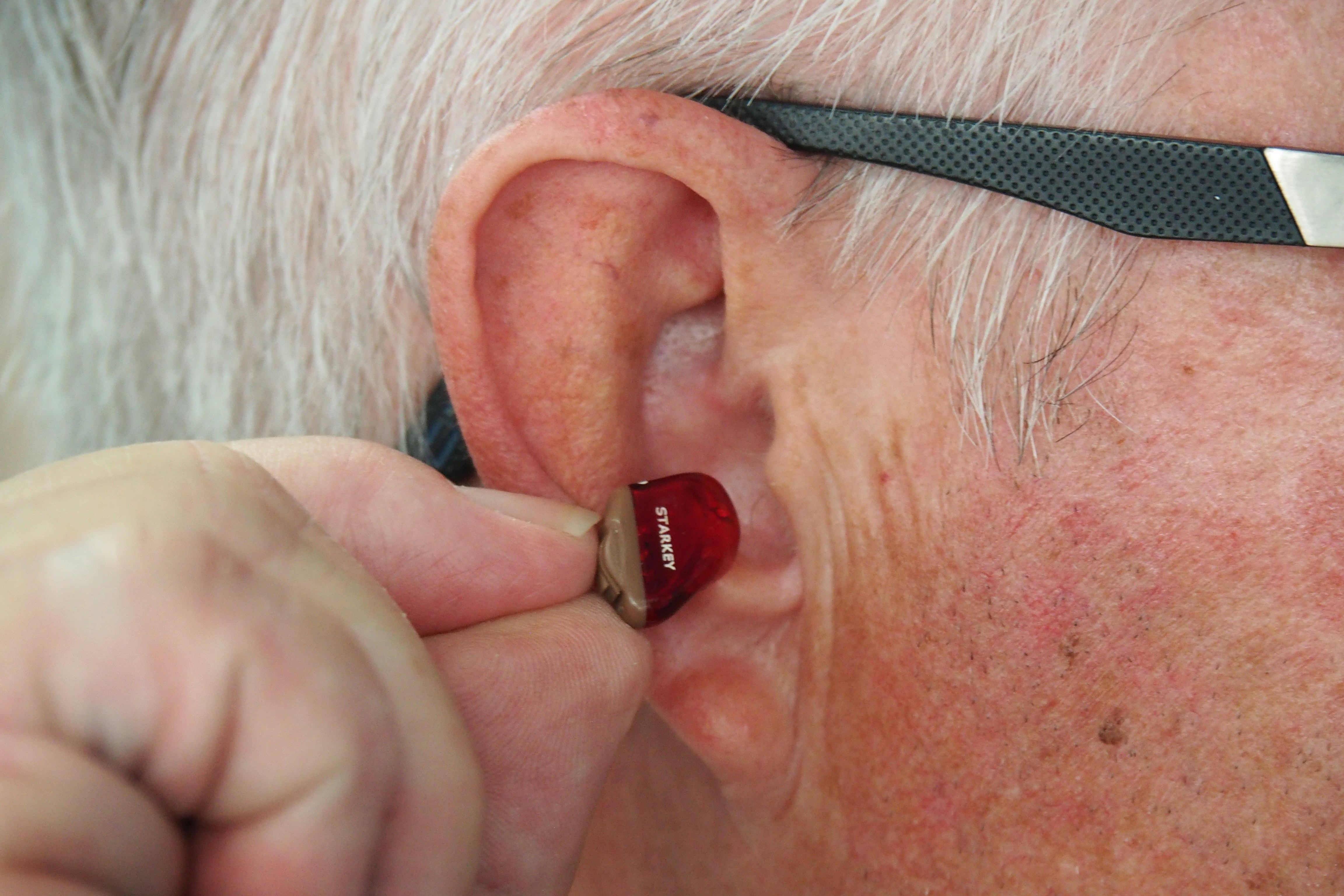Hearing aids turn up sound. Auditory training teaches your brain what to do with it. If voices blur together in busy places, this is your missing piece.
Why conversations still feel hard—even with good hearing aids
You’re not imagining it: even the best-fitted hearing aids can leave you working overtime in restaurants, meetings, and family gatherings. That’s because “hearing” happens in two places—your ears and your brain. The ears deliver sound; the brain sorts, focuses, and fills in the gaps.
After years of reduced input from hearing loss, your brain adapts (smart!) in ways that make real-world listening trickier (annoying!). Auditory training is rehab for those brain pathways—like physical therapy for listening. The goal isn’t superhuman hearing; it’s smoother everyday communication with less effort.
Auditory training, defined (and demystified)
Auditory training is a structured set of listening exercises that gradually increase in difficulty. You practice:
- Bottom-up skills: hearing soft consonants, catching rapid speech, telling similar sounds apart (think “sat” vs. “sat” with background hum).
- Top-down skills: using context, memory, and attention to follow a fast talker or filter out clatter.
It can be delivered in clinic sessions, through coached programs, or via at-home apps and computer software. Most effective programs mix real speech in noise, variable talkers, and tasks that stretch memory and attention—because that’s what conversation demands.
Who benefits most?
Auditory training is worth considering if you:
- Hear okay in quiet, but struggle in noise, groups, or on the phone.
- Use hearing aids or a cochlear implant and want better speech clarity.
- Feel listening fatigue by late afternoon.
- Are returning to work, school, or social life and need to sharpen listening stamina.
It’s not a fix for sudden hearing loss, ear pain, spinning dizziness, or other medical red flags—see an audiologist or ENT promptly for those. Training also isn’t a replacement for properly fitted hearing aids or cochlear implants; it works best on top of well-optimized devices.
What the evidence says (realistic expectations)
Research on adult auditory training shows small-to-moderate improvements in:
- Performance on trained listening tasks (like recognizing words in background noise).
- Self-reported ease of listening and communication confidence.
- Sometimes, transfer to new tasks (for example, better scores on a different speech-in-noise test).
Results vary. People who stick with a program 20–30 minutes a day, 3–5 days a week for 4–8 weeks tend to report the most benefit. Think of it as fitness for your listening brain: consistent practice beats occasional marathons.
Most studies caution that training is not magic. It can nudge your signal-to-noise handling in the right direction and lower perceived effort, especially when paired with well-fit hearing aids and everyday communication strategies.
Choose your training path
1) Clinic-based and coached programs
Great if you want accountability, customization, and feedback. Your audiologist can tailor exercises to your hearing profile, adjust hearing aid settings to match your progress, and measure change with validated tools.
Ask your clinic about options like:
- In-office aural rehabilitation sessions (individual or small group).
- Hybrid programs that combine home exercises with telecoaching.
- Multicomponent platforms that blend training, education, and support communities.
2) At-home apps and software (self-paced)
These are accessible and affordable, and many offer trial periods. Common categories:
- Speech-in-noise drills: practice understanding words and sentences in varying background noise and accents.
- Phoneme contrast training: sharpen awareness of similar sounds (s/sh, b/p).
- Cognitive-listening games: dual-tasking, memory for sequences, or attention shifting.
Examples you might encounter include LACE, HearCoach, Angel Sound (especially for cochlear implant users), and other speech-in-noise trainers. We don’t endorse specific brands here; the right choice depends on your goals, device, and budget. Your audiologist can help you pick and set difficulty levels.
Build a 6-week plan that sticks
Here’s a simple, research-aligned framework you can adapt with your clinician:
Time and frequency
- Target 20–30 minutes per session, 4 days per week, for 6 weeks.
- Shorter, consistent sessions are better than irregular long ones.
Your weekly mix
- Two sessions: speech-in-noise practice (sentences with café noise, fluctuating levels).
- One session: phoneme or rapid-speech drills (contrast minimal pairs, time-compressed speech).
- One session: cognitive-listening tasks (remembering word lists while ignoring distractors).
How to progress
- Start at a success rate of ~70–80% to stay motivated.
- As you hit 85–90% consistently, increase difficulty: lower the signal-to-noise ratio, change voices, speed up speech, or add competing talkers.
- Include real-life transfers: once a week, test your new skills—call a friend on speaker in a moderate-noise room; attend a small group and sit strategically; try a podcast at 1.25x speed with captions off, then on.
Gear checklist
- Use your hearing aids or implant during training unless a program specifies otherwise.
- Good headphones and a quiet room help you control difficulty.
- Keep a notebook or notes app to track wins, tough spots, and questions for your audiologist.
Partner strategies that multiply gains
Training works best when you also shape the environment and communication habits. Try these alongside your exercises:
- Positioning: face the talker; reduce distance; choose seats with your back to a wall.
- Noise control: turn off unused TVs, choose quieter corners, ask for a table away from speakers.
- Clarifying phrases: “Can you say that in another way?” often beats “What?”
- Chunk and confirm: summarize what you heard—“So we’re meeting at 3 on Elm?”—to close the loop.
- Tech assist: use your hearing aid’s speech-in-noise program, remote mic, or directional focus in group settings. Practice switching programs quickly.
How to measure progress (so you know it’s working)
Objective plus subjective measures give the clearest picture. Consider:
- Speech-in-noise tests: clinics can run QuickSIN, DIN (digits-in-noise), or similar measures before and after training.
- Self-report scales: brief questionnaires like the SSQ12 or COSI capture real-world changes you feel.
- Listening effort diary: rate your daily listening energy from 1–10; look for a downward trend.
- Hearing aid data logs: ask your audiologist how much time you spend in noisy settings and whether you’re using special programs or accessories.
If you don’t notice any change by week 3 or 4, don’t push through frustration—talk to your audiologist. You may need different drills, a slower progression, or a hearing aid setting tweak (like stronger noise reduction, better directional microphones, or a remote mic).
Special situations
Tinnitus on top of hearing loss
Auditory training can still help, especially when paired with sound therapy and counseling. Look for programs that let you add gentle background sound and practice attention shifting—the skill of noticing, then refocusing away from the tinnitus.
Auditory processing challenges
If your tests suggest central auditory processing difficulties, your clinician may emphasize tasks that train temporal processing (following rapid speech) and competing speech. Expect a slower build and more repetition, with gains focused on specific listening goals (classroom, meetings, phone).
Common pitfalls (and how to dodge them)
- All at once: cramming long sessions leads to fatigue without better results. Keep it bite-sized.
- Too easy, too long: if you’re bored, your brain isn’t changing. Increase challenge once you’re at ~85% success.
- Wrong difficulty: if you’re below 60% accuracy, dial it back. Productive struggle, not overwhelm.
- Going it alone: a 15-minute check-in with your audiologist can salvage motivation and tailor settings.
When to bring in the pros (please do!)
Consider a formal consult if you:
- Have sudden hearing changes, ear pain, drainage, or spinning dizziness.
- Feel your hearing aids aren’t pulling their weight in noise.
- Have tried training for 2–4 weeks with no improvement.
- Prefer guided coaching and accountability.
Audiologists can help you select the right program, verify and fine-tune your hearing aid settings, measure progress, and add tools like remote microphones or captioning to your toolbox.
The bottom line
Auditory training won’t turn a stadium into a library—but it can make voices stand out, reduce listening effort, and bring back confidence in conversations. Think of it as brain cross-training for better everyday hearing. Start small, be consistent, and loop in your audiologist to personalize the plan. Your future self at the next dinner party will thank you.
Further Reading
- Listening Fatigue Is Real: Use Your Hearing Aids to Spend Less Energy on Every Conversation (Hearing Aids) - Hyperacusis Treatment: Rebuild Your Sound Tolerance Without Hiding (Treatment) - AI in Hearing Aids: Myth, Reality, and How to Get Better Speech-in-Noise (Technology) - Your Ears, Your Brain: The Cognitive Upside of Treating Hearing Loss (Hearing Loss)Frequently Asked Questions
Should I do auditory training with or without my hearing aids?
Use your hearing aids or cochlear implant during training unless a program specifically instructs otherwise. You want to practice with the sound you actually hear in daily life, and your devices provide essential clarity and access to speech cues.
How long before I notice results?
Many people report modest improvements in 2–4 weeks with 20–30 minutes of practice, 3–5 days per week. Expect gradual changes: a bit easier time following fast talkers, less fatigue by day’s end, and better comprehension in moderate noise. If nothing changes by week 4, ask your audiologist to adjust the plan.
Are there risks to auditory training?
It’s generally low-risk. The main pitfalls are frustration and listening fatigue if the difficulty is set too high or sessions run too long. Keep sessions short, progress gradually, and take breaks. Stop and consult your clinician if you experience new ear symptoms (pain, drainage, sudden changes, spinning).
Can auditory training replace hearing aids?
No. Training and devices do different jobs. Hearing aids or cochlear implants give you access to speech sounds; training helps your brain make better use of that input. They’re most effective together.
References
- World Health Organization. World Report on Hearing (2021) – Rehabilitation and hearing care.
- National Institute on Deafness and Other Communication Disorders (NIDCD). Cochlear Implants and Hearing Aids – Rehabilitation information.
- Mayo Clinic. Hearing loss: Diagnosis and treatment.
- Sweetow RW, Palmer CV. Efficacy of individual auditory training in adults: A systematic review. Journal of the American Academy of Audiology. 2005.
- National Academies of Sciences, Engineering, and Medicine. Hearing Health Care for Adults: Priorities for Improving Access and Affordability (2016).



